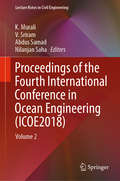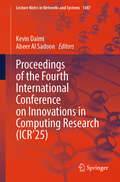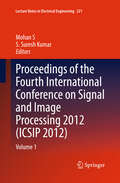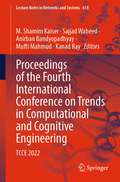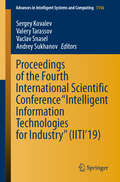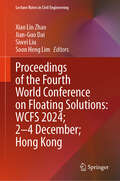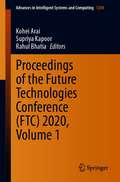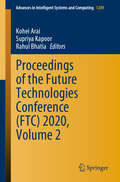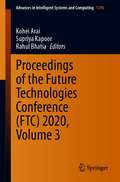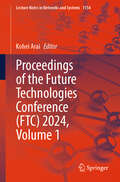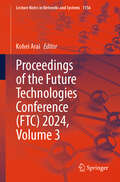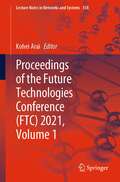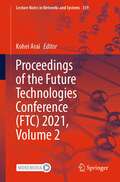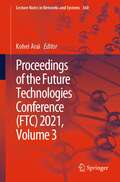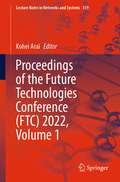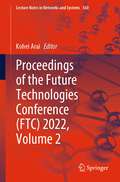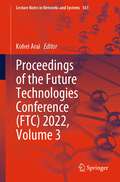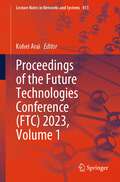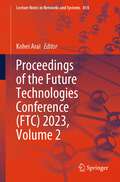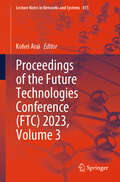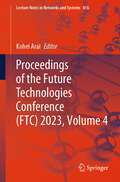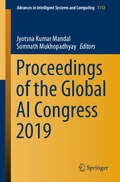- Table View
- List View
Proceedings of the Fourth International Conference in Ocean Engineering: Volume 2 (Lecture Notes in Civil Engineering #23)
by V. Sriram Abdus Samad K. Murali Nilanjan SahaThis book comprises selected proceedings of the Fourth International Conference in Ocean Engineering (ICOE2018), focusing on emerging opportunities and challenges in the field of ocean engineering and offshore structures. It includes state-of-the-art content from leading international experts, making it a valuable resource for researchers and practicing engineers alike.
Proceedings of the Fourth International Conference on Innovations in Computing Research (Lecture Notes in Networks and Systems #1487)
by Kevin Daimi Abeer AlsadoonThis book concentrates on innovations in research in the areas of Data Science, Computer Science and Computer Engineering Education, Computer and Network Security, Health Informatics and Digital Imaging, Internet of Things, Smart Cities and Smart Energy, and Quantum Computing The Fourth International Conference on Innovations in Computing Research (ICR&’25), August 25–27, 2025, London, UK, brings together a diverse group of researchers from all over the world with the intent of fostering collaboration and dissemination of the innovations in computing technologies. The conference is aptly segmented into seven tracks to promote a birds-of-the-same-feather congregation and maximize participation. This book introduces the concepts, techniques, methods, approaches, and trends needed by researchers, graduate students, specialists, and educators for keeping current and enhancing their research and knowledge in these areas.
Proceedings of the Fourth International Conference on Microelectronics, Computing and Communication Systems: MCCS 2019 (Lecture Notes in Electrical Engineering #673)
by J. K. Mandal Vijay NathThis book presents high-quality papers from the Fourth International Conference on Microelectronics, Computing & Communication Systems (MCCS 2019). It discusses the latest technological trends and advances in MEMS and nanoelectronics, wireless communication, optical communication, instrumentation, signal processing, image processing, bioengineering, green energy, hybrid vehicles, environmental science, weather forecasting, cloud computing, renewable energy, RFID, CMOS sensors, actuators, transducers, telemetry systems, embedded systems and sensor network applications. It includes papers based on original theoretical, practical and experimental simulations, development, applications, measurements and testing. The applications and solutions discussed here provide excellent reference material for future product development.
Proceedings of the Fourth International Conference on Signal and Image Processing 2012 (ICSIP #2012)
by Mohan S S Suresh KumarThe proceedings includes cutting-edge research articles from the Fourth International Conference on Signal and Image Processing (ICSIP), which is organised by Dr. N.G.P. Institute of Technology, Kalapatti, Coimbatore. The Conference provides academia and industry to discuss and present the latest technological advances and research results in the fields of theoretical, experimental, and application of signal, image and video processing. The book provides latest and most informative content from engineers and scientists in signal, image and video processing from around the world, which will benefit the future research community to work in a more cohesive and collaborative way.
Proceedings of the Fourth International Conference on Trends in Computational and Cognitive Engineering: TCCE 2022 (Lecture Notes in Networks and Systems #618)
by Kanad Ray Anirban Bandyopadhyay Mufti Mahmud M. Shamim Kaiser Sajjad WaheedThis book presents various computational and cognitive modeling approaches in the areas of health, education, finance, environment, engineering, commerce, and industry. It is a collection of selected conference papers presented at the 4th International Conference on Trends in Cognitive Computation Engineering (TCCE 2022), hosted by Mawlana Bhashani Science and Technology University, Tangail, Bangladesh, during December 17–18, 2022. It shares cutting-edge insights and ideas from mathematicians, engineers, scientists, and researchers and discusses fresh perspectives on problem solving in a range of research areas.
Proceedings of the Fourth International Scientific Conference “Intelligent Information Technologies for Industry” (Advances in Intelligent Systems and Computing #1156)
by Vaclav Snasel Sergey Kovalev Valery Tarassov Andrey SukhanovThis book gathers papers presented in the main track of IITI 2019, the Fourth International Scientific Conference on Intelligent Information Technologies for Industry, held in Ostrava–Prague, Czech Republic on December 2–7, 2019. The conference was jointly organized by Rostov State Transport University (Russia) and VŠB – Technical University of Ostrava (Czech Republic) with the participation of the Russian Association for Artificial Intelligence (RAAI). IITI 2019 was devoted to practical models and industrial applications of intelligent information systems. Though chiefly intended to promote the implementation of advanced information technologies in various industries, topics such as the state of the art in intelligent systems and soft computing were also discussed.
Proceedings of the Fourth World Conference on Floating Solutions: WCFS 2024; 2–4 December; Hong Kong (Lecture Notes in Civil Engineering #597)
by Soon Heng Lim Xiao Lin Zhao Jian-Guo Dai Siwei LiuThis book highlights recent research and development in floating solutions for sustainable ocean development and blue economy. It covers the following key topics: Architecture; climate change and disaster; environmental enhancement; food security and food sustainability; innovation and technology; renewable energy; urban planning; policy, social acceptance and legal matters. This book is of interest to architectures, engineers, consultants, manufactures, government officials, researchers, academics, and postgraduate students related to floating solutions.
Proceedings of the Future Technologies Conference (Advances in Intelligent Systems and Computing #1288)
by Kohei Arai Supriya Kapoor Rahul BhatiaThis book provides the state-of-the-art intelligent methods and techniques for solving real-world problems along with a vision of the future research.The fifth 2020 Future Technologies Conference was organized virtually and received a total of 590 submissions from academic pioneering researchers, scientists, industrial engineers, and students from all over the world. The submitted papers covered a wide range of important topics including but not limited to computing, electronics, artificial intelligence, robotics, security and communications and their applications to the real world. After a double-blind peer review process, 210 submissions (including 6 poster papers) have been selected to be included in these proceedings.One of the meaningful and valuable dimensions of this conference is the way it brings together a large group of technology geniuses in one venue to not only present breakthrough research in future technologies, but also to promote discussions and debate of relevant issues, challenges, opportunities and research findings. The authors hope that readers find the book interesting, exciting and inspiring
Proceedings of the Future Technologies Conference (Advances in Intelligent Systems and Computing #1289)
by Kohei Arai Supriya Kapoor Rahul BhatiaThis book provides the state-of-the-art intelligent methods and techniques for solving real-world problems along with a vision of the future research.The fifth 2020 Future Technologies Conference was organized virtually and received a total of 590 submissions from academic pioneering researchers, scientists, industrial engineers, and students from all over the world. The submitted papers covered a wide range of important topics including but not limited to computing, electronics, artificial intelligence, robotics, security and communications and their applications to the real world. After a double-blind peer review process, 210 submissions (including 6 poster papers) have been selected to be included in these proceedings.One of the meaningful and valuable dimensions of this conference is the way it brings together a large group of technology geniuses in one venue to not only present breakthrough research in future technologies, but also to promote discussions and debate of relevant issues, challenges, opportunities and research findings. The authors hope that readers find the book interesting, exciting and inspiring.
Proceedings of the Future Technologies Conference (Advances in Intelligent Systems and Computing #1290)
by Kohei Arai Supriya Kapoor Rahul BhatiaThis book provides the state-of-the-art intelligent methods and techniques for solving real-world problems along with a vision of the future research.The fifth 2020 Future Technologies Conference was organized virtually and received a total of 590 submissions from academic pioneering researchers, scientists, industrial engineers, and students from all over the world. The submitted papers covered a wide range of important topics including but not limited to computing, electronics, artificial intelligence, robotics, security and communications and their applications to the real world. After a double-blind peer review process, 210 submissions (including 6 poster papers) have been selected to be included in these proceedings.One of the meaningful and valuable dimensions of this conference is the way it brings together a large group of technology geniuses in one venue to not only present breakthrough research in future technologies, but also to promote discussions and debate of relevant issues, challenges, opportunities and research findings. The authors hope that readers find the book interesting, exciting and inspiring.
Proceedings of the Future Technologies Conference (Lecture Notes in Networks and Systems #1154)
by Kohei AraiThis book covers proceedings of the Future Technologies Conference (FTC) 2024 which showcase a collection of thoroughly researched studies presented at the ninth Future Technologies Conference, held in London, the UK. This premier annual event highlights groundbreaking research in artificial intelligence, computer vision, data science, computing, ambient intelligence, and related fields. With 476 submissions, FTC 2024 gathers visionary minds to explore innovative solutions to today's most pressing challenges. The 173 selected papers represent cutting-edge advancements that foster vital conversations and future collaborations in the realm of information technologies. The authors extend their deepest gratitude to all contributors, reviewers, and participants for making FTC 2024 an unparalleled success. The authors hope this volume inspires and informs its readers, encouraging continued exploration and innovation in future technologies.
Proceedings of the Future Technologies Conference (Lecture Notes in Networks and Systems #1155)
by Kohei AraiThis book covers proceedings of the Future Technologies Conference (FTC) 2024 which showcase a collection of thoroughly researched studies presented at the ninth Future Technologies Conference, held in London, the UK. This premier annual event highlights groundbreaking research in artificial intelligence, computer vision, data science, computing, ambient intelligence, and related fields. With 476 submissions, FTC 2024 gathers visionary minds to explore innovative solutions to today's most pressing challenges. The 173 selected papers represent cutting-edge advancements that foster vital conversations and future collaborations in the realm of information technologies. The authors extend their deepest gratitude to all contributors, reviewers, and participants for making FTC 2024 an unparalleled success. The authors hope this volume inspires and informs its readers, encouraging continued exploration and innovation in future technologies.
Proceedings of the Future Technologies Conference (Lecture Notes in Networks and Systems #1156)
by Kohei AraiThis book covers proceedings of the Future Technologies Conference (FTC) 2024 which showcase a collection of thoroughly researched studies presented at the ninth Future Technologies Conference, held in London, the UK. This premier annual event highlights groundbreaking research in artificial intelligence, computer vision, data science, computing, ambient intelligence, and related fields. With 476 submissions, FTC 2024 gathers visionary minds to explore innovative solutions to today's most pressing challenges. The 173 selected papers represent cutting-edge advancements that foster vital conversations and future collaborations in the realm of information technologies. The authors extend their deepest gratitude to all contributors, reviewers, and participants for making FTC 2024 an unparalleled success. The authors hope this volume inspires and informs its readers, encouraging continued exploration and innovation in future technologies.
Proceedings of the Future Technologies Conference (Lecture Notes in Networks and Systems #1157)
by Kohei AraiThis book covers proceedings of the Future Technologies Conference (FTC) 2024 which showcase a collection of thoroughly researched studies presented at the ninth Future Technologies Conference, held in London, the UK. This premier annual event highlights groundbreaking research in artificial intelligence, computer vision, data science, computing, ambient intelligence, and related fields. With 476 submissions, FTC 2024 gathers visionary minds to explore innovative solutions to today's most pressing challenges. The 172 selected papers represent cutting-edge advancements that foster vital conversations and future collaborations in the realm of information technologies. The authors extend their deepest gratitude to all contributors, reviewers, and participants for making FTC 2024 an unparalleled success. The authors hope this volume inspires and informs its readers, encouraging continued exploration and innovation in future technologies.
Proceedings of the Future Technologies Conference (Lecture Notes in Networks and Systems #358)
by Kohei AraiThis book covers a wide range of important topics including but not limited to Technology Trends, Computing, Artificial Intelligence, Machine Vision, Communication, Security, e-Learning, and Ambient Intelligence and their applications to the real world. The sixth Future Technologies Conference 2021 was organized virtually and received a total of 531 submissions from academic pioneering researchers, scientists, industrial engineers, and students from all over the world.. After a double-blind peer review process, 191 submissions have been selected to be included in these proceedings.One of the meaningful and valuable dimensions of this conference is the way it brings together a large group of technology geniuses in one venue to not only present breakthrough research in future technologies, but also to promote discussions and debate of relevant issues, challenges, opportunities and research findings. We hope that readers find the book interesting, exciting, and inspiring; it provides the state-of-the-art intelligent methods and techniques for solving real-world problems along with a vision of the future research.
Proceedings of the Future Technologies Conference (Lecture Notes in Networks and Systems #359)
by Kohei AraiThis book covers a wide range of important topics including but not limited to Technology Trends, Computing, Artificial Intelligence, Machine Vision, Communication, Security, e-Learning, and Ambient Intelligence and their applications to the real world. The sixth Future Technologies Conference 2021 was organized virtually and received a total of 531 submissions from academic pioneering researchers, scientists, industrial engineers, and students from all over the world. After a double-blind peer review process, 191 submissions have been selected to be included in these proceedings.One of the meaningful and valuable dimensions of this conference is the way it brings together a large group of technology geniuses in one venue to not only present breakthrough research in future technologies, but also to promote discussions and debate of relevant issues, challenges, opportunities and research findings. We hope that readers find the book interesting, exciting, and inspiring; it provides the state-of-the-art intelligent methods and techniques for solving real-world problems along with a vision of the future research.
Proceedings of the Future Technologies Conference (Lecture Notes in Networks and Systems #360)
by Kohei AraiThis book provides the state-of-the-art intelligent methods and techniques for solving real world problems along with a vision of the future research. The sixth Future Technologies Conference 2021 was organized virtually and received a total of 531 submissions from academic pioneering researchers, scientists, industrial engineers, and students from all over the world. The submitted papers covered a wide range of important topics including but not limited to technology trends, computing, artificial intelligence, machine vision, communication, security, e-learning and ambient intelligence and their applications to the real world. After a double-blind peer-reviewed process, 191 submissions have been selected to be included in these proceedings.One of the meaningful and valuable dimensions of this conference is the way it brings together a large group of technology geniuses in one venue to not only present breakthrough research in future technologies but also to promote discussions and debate of relevant issues, challenges, opportunities, and research findings. We hope that readers find the volume interesting, exciting, and inspiring.
Proceedings of the Future Technologies Conference (Lecture Notes in Networks and Systems #559)
by Kohei AraiThe seventh Future Technologies Conference 2022 was organized in a hybrid mode. It received a total of 511 submissions from learned scholars, academicians, engineers, scientists and students across many countries. The papers included the wide arena of studies like Computing, Artificial Intelligence, Machine Vision, Ambient Intelligence and Security and their jaw- breaking application to the real world. After a double-blind peer review process 177 submissions have been selected to be included in these proceedings.One of the prominent contributions of this conference is the confluence of distinguished researchers who not only enthralled us by their priceless studies but also paved way for future area of research. The papers provide amicable solutions to many vexing problems across diverse fields. They also are a window to the future world which is completely governed by technology and its multiple applications.We hope that the readers find this volume interesting and inspiring and render their enthusiastic support towards it.
Proceedings of the Future Technologies Conference (Lecture Notes in Networks and Systems #560)
by Kohei AraiThe seventh Future Technologies Conference 2022 was organized in a hybrid mode. It received a total of 511 submissions from learned scholars, academicians, engineers, scientists and students across many countries. The papers included the wide arena of studies like Computing, Artificial Intelligence, Machine Vision, Ambient Intelligence and Security and their jaw- breaking application to the real world. After a double-blind peer review process 177 submissions have been selected to be included in these proceedings.One of the prominent contributions of this conference is the confluence of distinguished researchers who not only enthralled us by their priceless studies but also paved way for future area of research. The papers provide amicable solutions to many vexing problems across diverse fields. They also are a window to the future world which is completely governed by technology and its multiple applications.We hope that the readers find this volume interesting and inspiring and render their enthusiastic support towards it.
Proceedings of the Future Technologies Conference (Lecture Notes in Networks and Systems #561)
by Kohei AraiThe seventh Future Technologies Conference 2022 was organized in a hybrid mode. It received a total of 511 submissions from learned scholars, academicians, engineers, scientists and students across many countries. The papers included the wide arena of studies like Computing, Artificial Intelligence, Machine Vision, Ambient Intelligence and Security and their jaw- breaking application to the real world. After a double-blind peer review process 177 submissions have been selected to be included in these proceedings.One of the prominent contributions of this conference is the confluence of distinguished researchers who not only enthralled us by their priceless studies but also paved way for future area of research. The papers provide amicable solutions to many vexing problems across diverse fields. They also are a window to the future world which is completely governed by technology and its multiple applications.We hope that the readers find this volume interesting and inspiring and render their enthusiastic support towards it.
Proceedings of the Future Technologies Conference (Lecture Notes in Networks and Systems #813)
by Kohei AraiThis book is a collection of thoroughly well-researched studies presented at the Eighth Future Technologies Conference. This annual conference aims to seek submissions from the wide arena of studies like Computing, Communication, Machine Vision, Artificial Intelligence, Ambient Intelligence, Security, and e-Learning. With an impressive 490 paper submissions, FTC emerged as a hybrid event of unparalleled success, where visionary minds explored groundbreaking solutions to the most pressing challenges across diverse fields. These groundbreaking findings open a window for vital conversation on information technologies in our community especially to foster future collaboration with one another. We hope that the readers find this book interesting and inspiring and render their enthusiastic support toward it.
Proceedings of the Future Technologies Conference (Lecture Notes in Networks and Systems #814)
by Kohei AraiThis book is a collection of thoroughly well-researched studies presented at the Eighth Future Technologies Conference. This annual conference aims to seek submissions from the wide arena of studies like Computing, Communication, Machine Vision, Artificial Intelligence, Ambient Intelligence, Security, and e-Learning. With an impressive 490 paper submissions, FTC emerged as a hybrid event of unparalleled success, where visionary minds explored groundbreaking solutions to the most pressing challenges across diverse fields. These groundbreaking findings open a window for vital conversation on information technologies in our community especially to foster future collaboration with one another. We hope that the readers find this book interesting and inspiring and render their enthusiastic support toward it.
Proceedings of the Future Technologies Conference (Lecture Notes in Networks and Systems #815)
by Kohei AraiThis book is a collection of thoroughly well-researched studies presented at the Eighth Future Technologies Conference. This annual conference aims to seek submissions from the wide arena of studies like Computing, Communication, Machine Vision, Artificial Intelligence, Ambient Intelligence, Security, and e-Learning. With an impressive 490 paper submissions, FTC emerged as a hybrid event of unparalleled success, where visionary minds explored groundbreaking solutions to the most pressing challenges across diverse fields. These groundbreaking findings open a window for vital conversation on information technologies in our community especially to foster future collaboration with one another. We hope that the readers find this book interesting and inspiring and render their enthusiastic support toward it.
Proceedings of the Future Technologies Conference (Lecture Notes in Networks and Systems #816)
by Kohei AraiThis book is a collection of thoroughly well-researched studies presented at the Eighth Future Technologies Conference. This annual conference aims to seek submissions from the wide arena of studies like Computing, Communication, Machine Vision, Artificial Intelligence, Ambient Intelligence, Security, and e-Learning. With an impressive 490 paper submissions, FTC emerged as a hybrid event of unparalleled success, where visionary minds explored groundbreaking solutions to the most pressing challenges across diverse fields. These groundbreaking findings open a window for vital conversation on information technologies in our community especially to foster future collaboration with one another. We hope that the readers find this book interesting and inspiring and render their enthusiastic support toward it.
Proceedings of the Global AI Congress 2019 (Advances in Intelligent Systems and Computing #1112)
by Jyotsna Kumar Mandal Somnath MukhopadhyayThis book gathers high-quality research papers presented at the Global AI Congress 2019, which was organized by the Institute of Engineering and Management, Kolkata, India, on 12–14 September 2019. Sharing contributions prepared by researchers, practitioners, developers and experts in the areas of artificial intelligence, the book covers the areas of AI for E-commerce and web applications, AI and sensors, augmented reality, big data, brain computing interfaces, computer vision, cognitive radio networks, data mining, deep learning, expert systems, fuzzy sets and systems, image processing, knowledge representation, nature-inspired computing, quantum machine learning, reasoning, robotics and autonomous systems, robotics and the IoT, social network analysis, speech processing, video processing, and virtual reality.
